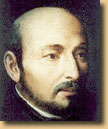Counter-Reformation

Ignatius Loyola
(1491-1556)
Founder of the Jesuits, so instrumental in the Catholic Counter-Reformation


Counter-Reformation
Adapted and compressed from 'A History of Europe' by Norman Davies, (Oxford) Chap VII
The Counter-Reformation was given its name by Protestant historians who assumed it was born to oppose the Protestant Reformation. Catholic historians see it differently, as the second stage of a movement for Church reform which had a continuous history from the conciliarists of the late 14th century to the Council of Trent. It can also be seen as a natural consequence of men's desire to know the real God and not the Church's depiction of Him. Men's hearts were revived and they responded in the way they knew how. In any case this was a period of Catholic reassertion and counterattack to regain much lost territory and reputation.
Though Pope Paul III was a blatant nepotist, he saw the urgency of change. He revitalised the Sacred College, commisioned the key inquiry into Church reform, patronized the Jesuits, established the Holy Office and launched the Council of Trent.
The particular religious ethos promoted by the Counter-Reformation emphasized the discipline and collective life of the faithful. It reflected the wide powers of enforcement given to the hierarchy, and the outward show of conformity which believers were now required to display, in direct opposition to Jesus' teaching in the Sermon on the Mount.
It insisted on public confession as a sign of submission. It was supported by a wide range of communal practices — pilgrimages, ceremonies and processions — and by the calculated theatricals the accompanying art, architecture and music. Catholic propaganda of this vintage was both strong on rational argument, and on devices for impressing the senses, and led to a burst of creative activity. The Baroque churches of the era, crammed with altars, columns, statues, cherubs, gold leaf, icons, monstrances, candelabra and incense were designed to leave nothing to private contemplation. Unlike the Protestant preachers, who stressed individual conscience and individual probity, all too often the Catholic clergy seemed to urge their flock to blind obedience.
Some Countries Counter-Reformed
In France a pro-Roman 'ultramontane' party grew in prominence round the faction of the Guises. Their darkest deed was the masscare committed on St. Bartolomew's Eve (23rd August 1572) when they butchered over 2000 Huguenots in Paris — after which the Pope celebrated with a Te Deum and the King Phillip II of Spain (Bloody Mary's one time husband) began to laugh.
The Kingdom of England was targeted for reconversion in a campaign that spawned the Forty Catholic Martyrs led by St. Edmund Campion SJ (1540-1581). Ireland was confirmed in its Catholicism, especially after the expedition of 1598, when the complete conquest of Ireland became a strategic necessity for Elizabeth I during a time when Spain threatened to use the island as a means of challenging England from the west. But Protestant testimony returned to Ireland by the planting of a Scottish Presbyterian colony in Ulster in 1611, and by the Anglican inclinations of the Anglo-Irish gentry.
In the lands of the Austrian Habsburgs, the Jesuits took an unrivalled hold over education in Vienna and Prague through the efforts of the Dutchman, Canisius. Western Hungary, Slovakia, Croatia, Silesia, Bohemia, and later western Galicia all belonged to this same sphere.
Elsewhere in Germany, Spanish priests set up Jesuit centres at Cologne, Mainz, Ingolstadt and Munich, creating durable Catholic bastions in the Rhineland and Bavaria. Conflict between these areas and those under the jurisdiction of Protestant princes eventually led to the outbreak of the 30-years war (1618-1648).
In this world of growing religious intolerance, Poland-Lithuania occupied a place apart. A vast territory with a very varied population, it had contained a mosaic of Catholic, Othodox, Judaic and Muslim adherents even before Lutheranism claimed the cities of Polish Prussia or Calvinism a sizeable section of the nobility. Such was the position of the ruling szlachta that every manor could run its religious affairs with the same liberty as German princedoms.
At the very time that Jesuits were being introduced, Poland was receiving all manner of religious refugees — English and Scottish Catholics, Czech Brethren, Anabaptists from Holland and Italian Unitarians. Under Sigmund III Vasa (r. 1587-1632) a fervent pupil of the Jesuits, the ultamontane party gradually reasserted the Catholic Supremacy.
The Vatican entertained hopes of netting Sweden until the victory of the Protestants in the civil war of the 1590s dashed Jesuit hopes for good.
Clumsy Catholic pressure on Ivan the Terrible's son, Fedor, probably pushed him into creating the Moscow Patriarchate in 1589 thereby securing the emergence of the separate Russian Orthodox Church.
Baroque
The Counter-Reformation profoundly affected the progress of the arts all over Europe. Where music in Protestant countries, such as Holland or Scotland, was simplified to hymn-singing, in England the tradition of Anglican cathedral music was launched by Thomas Tallis and others. In Catholic countries, all branches of arts were ignited by demands for sumptuous and theatrical displays of the Church's glory and power. This trend is known as Baroque. Baroque painting was dominated by the Fleming Paul Rubens (1577-1640) and by the Spaniard Diego Velázquez (1599-1660). In architecture, the ubiquitous Baroque churches were often modelled on the Jesuit Gesú Church in Rome.
As the reemergence of a Catholic culture led to a series of unholy wars in the 16th and 17th centuries, one thing became clear. Senseless blodletting in the name of religion inevitably sparked off a reaction in the minds thinking people and offered fertile soil for the seeds of godless science and reason in the following centuries.